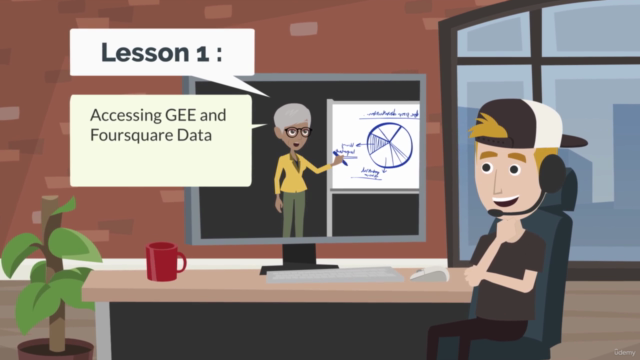Geospatial APIs For Data Science Applications In Python

Why take this course?
🌟 📚 Data Science With Google Earth Engine (GEE) and Foursquare With Python Using Application Programming Interfaces (APIs) - ENROLL TODAY! 🌟
🚀 Course Headline:
Master Geospatial Data Analysis with Python APIs: Unlock the Secrets of Remote Sensing and GIS with Google Earth Engine and Foursquare
📘 Course Description:
Are you on a quest to harness the power of geospatial data analysis without breaking the bank? Do you have a background in GIS or are looking to expand your skills beyond R and QGIS? Whether you're an aspiring data scientist, environmentalist, urban planner, or just curious about the world around us, this course is designed for YOU!
- Are you currently enrolled in my GIS and remote sensing related courses?
- If yes, this course will complement your skills further.
- Or perhaps you have prior experiences in GIS or tools like R and QGIS?
- This course will elevate your expertise to the next level.
- Do you want to quickly analyze large amounts of geospatial data?
- We'll cover techniques that enable rapid, efficient analysis.
- Interested in implementing machine learning models on remote sensing data?
- This course includes hands-on practice with these models.
- Want access to a multi-petabyte catalogue of satellite imagery and geospatial datasets?
- Google Earth Engine offers just that, and we'll show you how to tap into it.
- Looking for a cost-effective solution for planetary-scale analysis capabilities?
- You'll learn to leverage the cloud infrastructure provided by Google Earth Engine.
🧭 Course Highlights:
- Hands-On Training: Dive into real remote sensing and GIS data analysis with Google Earth Engine (GEE) – a planetary-scale platform for Earth science data & analysis.
- Practical Application: Apply your knowledge to solve actual geospatial problems, from identifying the best locations for a restaurant to understanding socio-economic changes in a territory.
- Expert Guidance: Benefit from my MPhil from the University of Oxford and PhD from Cambridge University (Tropical Ecology and Conservation) expertise.
- Publications & Research: Learn from someone who has published research in international peer-reviewed journals.
- Real-Life Data: Work with actual geospatial data obtained via Foursquare and GEE APIs to perform analysis and derive valuable insights.
- Comprehensive Learning: Focus on the most essential and widely encountered data science techniques applied to geospatial data.
🤝 Why This Course?
- Practical, Real-Life Skills: Learn how to apply data science and machine learning techniques effectively in real-world scenarios.
- Expertise & Experience: Gain insights from someone with years of experience analyzing geospatial data from a variety of sources.
- Continuous Support: I'm here to support you every step of the way to ensure you get the most value out of your learning journey.
🎓 About Your Instructor:
- Minerva Singh - With an MPhil from the University of Oxford and a PhD from Cambridge University, Minerva has extensive experience in analyzing geospatial data and producing peer-reviewed publications. Her expertise is your advantage.
🚀 Take Action!
Don't miss this opportunity to become proficient in using APIs for obtaining free geospatial datasets and deriving valuable insights from them. Enroll now and start your journey towards becoming an expert in geospatial analysis with the support of an experienced instructor. 🌎🔍
Enroll Now and Transform Your Data Science Skills with Google Earth Engine and Foursquare APIs!
Course Gallery




Loading charts...
Comidoc Review
Our Verdict
This course aims to equip learners with data science techniques and geospatial API skills using Python. However, the pacing and unclear explanations of specific concepts might prove challenging for beginners. It is advisable that students have prior Python knowledge as they dive into this engaging yet at times inconsistent exploration of Google Earth Engine (GEE) and Foursquare APIs. Despite minor shortcomings, learners will appreciate the valuable, practical applications presented throughout the course.
What We Liked
- The course provides a robust grounding in working with geospatial APIs using Python and covers data science methods on geospatial data.
- It thoroughly explains the Google Earth Engine (GEE) API within the Python ecosystem and how to use GEE's datasets for visualization and geospatial analysis.
- The course material boasts fascinating, clear explanations that are easy to follow, especially for those with a basic understanding of Python.
- Learners appreciate engaging lessons on geographic visualization using Geopy and Folium packages.
- Students find the introduction to Google Colab beneficial, enhancing their academic and professional map-making capabilities.
Potential Drawbacks
- It appears that some students struggle with the course's rapid pace and unclear explanations of specific concepts or jargon.
- There are reported inconsistencies in lecture continuity and several issues arise due to versioning and updates, causing difficulty following along.
- A few learners noted missing output when code examples were presented, posing a challenge for those looking to replicate the results.
- A number of students have expressed that certain machine learning sections felt incomplete or lacking detailed explanations.